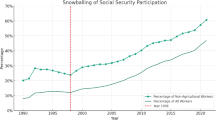Abstract
The research premise is that shift-share analysis can provide some useful policy information. The question addressed is: do governmental policies influence the competitive share of a county. Ordinary least squares regression is used to test the relationship between selected state and local government policy choices and the county's competitive share for the time periods of 1962–72, 1962–67, and 1967–72. The policy variables proved to have limited predictive power. The number of cities over 10,000 population, distance to Milwaukee/Minneapolis, percent employed in trade and service activities, and median family income were the strongest influences on county competitive share. The conclusion is that the proxies for state and local economic policy choices are either inadequate or county competitive share is not influenced by governmental action.
Similar content being viewed by others
References
Ashby, L. D., “The Shift and Share Analysis: A Reply,”Southern Economic Journal, Volume 34 (January 1968), pp. 423–425.
Brown, H. J., “Shift and Share Projections of Regional Economic Growth: An Empirical Test,”Journal of Regional Science, Vol. 9 (April 1969), pp. 1–18.
Buck, T. W., “Shift and Share Analysis--A Guide to Regional Policy,”Regional Studies, Volume 4 (December, 1970), pp. 445–450.
Davis, H. C. and M. A. Goldberg, “Combining Intersectoral Flows and Shift-Share Techniques: A Hybrid Regional Forecasting Model,”Annals of Regional Science, Volume 6 (June 1972), pp. 106–116.
Dunn, E. S., “A Statistical and Analytical Technique for Regional Analysis,”Papers Regional Association, Vol. 6 (1960), pp. 97–112.
Fuchs, V., “Statistical Explanation of the Relative Shift of Manufacturing Among Regions in the United States,”Papers Regional Science Association, Vol. 8 (1962), pp. 105–126.
Gordon, J. R. and D. Darling, “Measuring Economic Growth in Rural Communities; The Shift-Share Approach,” paper presented to 1976 meeting of the Mid-Continent Section of the Regional Science Association, Bowling Green University.
Houston, D. B., “The Shift and Share Analysis of Regional Growth: A Critique,” Southern Economic Journal, Vol. 33 (April, 1967), pp. 577–581.
Perloff, H. S., E. S. Dunn, E. E. Lampard and R. F. Muth,Regions, Resources and Economic Growth, The John Hopkins Press: Baltimore, 1960.
Weaver, R. and M. McMillan,Factors Influencing Manufacturing Change in Small Wisconsin Cities, 1960–1970, Research Bulletin R2776, College of Agriculture and Life Sciences, University of Wisconsin-Madison, January 1976.
Author information
Authors and Affiliations
Rights and permissions
About this article
Cite this article
Shaffer, R. Determinants of the competitive share in Wisconsin counties, 1962–1972: The role of government policy. Ann Reg Sci 13, 67–80 (1979). https://doi.org/10.1007/BF01284781
Issue Date:
DOI: https://doi.org/10.1007/BF01284781




